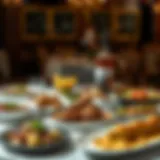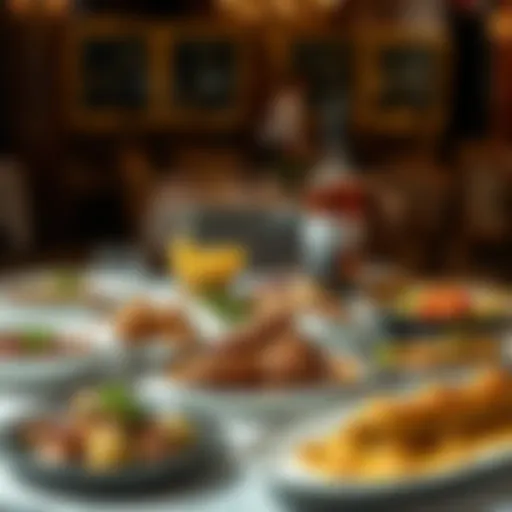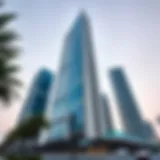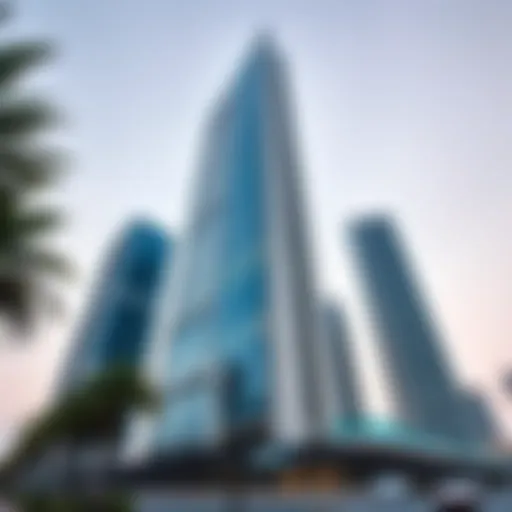Exploring Bur Dubai and Al Ghubaiba: A Complete Guide
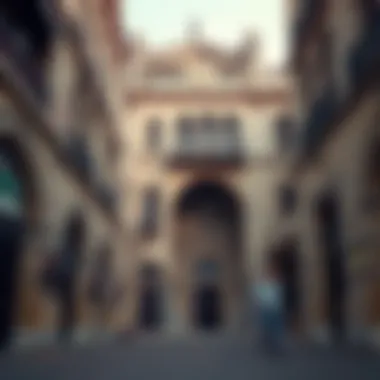

Intro
The regions of Bur Dubai and Al Ghubaiba stand as testaments to Dubai’s storied past while embracing the dynamics of modern urban life. As investors and homeowners contemplate their next moves in the ever-evolving skyline of Dubai, understanding the historical significance and present allure of these locales becomes crucial. From their bustling markets and picturesque streets to the sprawling residences and luxurious skyscrapers, these areas offer a unique blend of tradition and innovation that caters to a diverse populace.
In this guide, we aim to dissect the current market trends that shape the real estate landscape in Bur Dubai and Al Ghubaiba. We will investigate the property price movements that reflect the broader economic forces at play, while also highlighting investment opportunities ripe for exploration.
As we journey through the cultural nuances and property dynamics, it’s important to grasp the implications of urbanization and tourism on the local economy. Whether you’re a prospective investor aspiring to capitalize on high-growth areas or a resident weighing your options in the real estate arena, this comprehensive examination will illuminate the choices that await.
By exploring these facets, we not only highlight the key points of interest but also paint a broader picture of what it means to live and invest in these iconic neighborhoods. So, let’s delve into the framing of the market trends before venturing into the promising landscape of investment opportunities that lie ahead.
Overview of Bur Dubai
Understanding the fabric of Bur Dubai is essential, not just for those who live there but also for investors and analysts tuning into its vibrant pulse. This area is an epitome of Dubai's transition from a humble fishing village to a bustling metropolis, blending age-old traditions with modern living like peanut butter and jelly.
Historical Context
Bur Dubai has a history that runs deeper than most skyscrapers can reach. Established around the bank of the Dubai Creek, this area is a retrospective tapestry of trade, culture, and change. It was here during the late 19th century that the establishment of trading routes solidified Dubai's reputation as a trade hub. The Al Fahidi Fort, now home to the Dubai Museum, is a prominent landmark that hints at the region's military past. Local stories tell of the fort being built from coral stone and mud, embodying the very essence of Arabian architectural ingenuity.
What’s fascinating is how Bur Dubai’s history acknowledges the diverse communities that have coexisted over the decades. From traders to pearl divers, each group contributed to what the area has become. This melting pot of cultures adds an enriching layer for anyone wanting to appreciate modern Dubai in context.
Key Historical Events Impacting Bur Dubai:
- Formation of local trading alliances in the mid-1800s
- Discovery of oil in the 1960s that drastically changed the socio-economic landscape
- The establishment of the Dubai Municipality, organizing urban development in the late 1990s
Geographic Significance
Geographically, Bur Dubai holds a strategic vantage point. It lies opposite Deira, across the creek, acting as a bridge between the old and new. This location is not just convenient but is pivotal in connecting various neighborhoods, making it a focal point for commerce and lifestyle activities.
Bur Dubai is crisscrossed by key thoroughfares that facilitate easy navigation for residents and visitors alike. The proximity to the ferry services and Abra stations is invaluable, weaving a seamless connection to essential services and attractions. Additionally, the area's layout incorporates pockets of green spaces, parks, and traditional markets, balancing urban life with leisure in a fashion that one wouldn’t expect in a bustling city.
Cultural Landscape
The cultural landscape of Bur Dubai forms a rich mosaic that illustrates Dubai’s heritage while embracing global influences. This diversity is palpable in the area's architecture, cuisine, and festivals. The neighborhood boasts several mosques, galleries, and heritage sites, along with bustling souks that showcase local crafts and spices.
Cultural Highlights in Bur Dubai:
- Sheikh Mohammed Centre for Cultural Understanding: A spot where visitors can delve into Emirati culture and heritage through interactive experiences.
- The Dubai Frame: More than an architectural feat, it frames a dialogue between the city’s past and its aspirations for the future.
- Al Seef: This area merges old-world charm with modern amenities, dotted with cafes and shops proffering a taste of local life next to opulent surroundings.
In this rich tapestry of history, geography, and culture, Bur Dubai stands as a testament to the myriad influences that shape contemporary life in Dubai. The past informs the future, as investors and residents chart their paths through this crucial region.
Al Ghubaiba: Understanding the Area
Al Ghubaiba serves as a vital component when one delves into the heart of Bur Dubai. This neighborhood is not just a part of the city; it's an emblem of its own rich history and cultural tapestry. By examining Al Ghubaiba, we can appreciate the balance between past and present in Dubai, and how the area contributes significantly to the city’s civic identity, transport network, and cultural heritage. Ever since Dubai began transitioning from a humble fishing village into a thriving metropolis, Al Ghubaiba has played a pivotal role in this transformation.
Civic Identity
Civic identity in Al Ghubaiba is deeply marked by its historical roots and the diverse population that resides here. The area is often seen as a microcosm of Dubai's broader cultural landscape. One can find a mix of old and new buildings, bustling markets alongside modern cafes, and a harmony of different cultures co-existing in close proximity. This eclecticism is significant, as it shapes the community's character. The Dubai Creek, which borders Al Ghubaiba, has been a lifeline for trade for centuries, and the ongoing evolution of the creek district illustrates how history intertwines with modernity.
Moreover, the local community is actively involved in preserving the heritage that defines the area. Events celebrating Emirati traditions take place throughout the year, inviting participation from residents and visitors alike. With institutions like the Sheikh Mohammed Centre for Cultural Understanding, Al Ghubaiba fosters a sense of inclusivity and belonging. This proactive engagement with heritage allows for a vibrant civic identity that remains rooted in respect and celebration of its diverse cultures.
Transport Infrastructure
One cannot discuss the relevance of Al Ghubaiba without highlighting its robust transport infrastructure. At the center of this urban hub, Al Ghubaiba is well-connected, making it accessible to people from all over Dubai and beyond. The Dubai Metro, specifically the Green Line, has a station in Al Ghubaiba (Al Ghubaiba Metro Station), linking it seamlessly to key areas in the city.
Further, the RTA Water Bus services that link various points along Dubai Creek provide a scenic and convenient mode of transport. The bus and taxi services are frequently available, ensuring that residents and visitors can navigate the city efficiently. This comprehensive transport network enhances Al Ghubaiba's appeal for investors and businesses alike, as quick access often translates into economic opportunities. Knowing that commuting is hassle-free is a significant consideration for potential homebuyers and businesses looking to establish roots in the area.
Attractions and Landmarks
Al Ghubaiba isn't short on attractions that illustrate its unique character. Notably, the Dubai Museum, located in the historically rich Al Fahidi Fort, offers an insightful glimpse into the UAE's past. The blend of ancient artifacts and multimedia installations captivates tourists and locals alike, creating a bridge between the past and present.
Other landmarks worth mentioning include*:
- The Old Souk, known for its vibrant textiles and spices, captures the essence of traditional Arab commerce.
- Al Shindagha Historical District, which provides an experience of life in Dubai long before skyscrapers dotted the skyline.
- The Dubai Gold Souk, just a short distance away, showcases not only jewelry but the opulence of the city and its culture.
These attractions not only draw tourists but also serve as cultural touchstones for residents, reinforcing a sense of pride in their heritage. The combination of transport infrastructure and cultural landmarks places Al Ghubaiba as a sought-after destination, whether for tourists or potential investors seeking both lifestyle and business opportunities.
In summary, understanding Al Ghubaiba is essential for anyone looking to grasp the essence of Bur Dubai and the city of Dubai as a whole. The dynamic between civic identity, transport infrastructure, and historical attractions creates a compelling narrative that speaks to the richness of this area.
"To know Al Ghubaiba is to understand the heart of Dubai—its soul lies buried deep in the layers of culture, history, and progress that define it today."
For more information, visit:
Dubai Culture
Wikipedia on Dubai Creek
Visit Dubai - Al Ghubaiba
This exploration provides an essential foundation for investors, residents, and analysts eager to delve into the exciting developments that lie within these iconic wards.
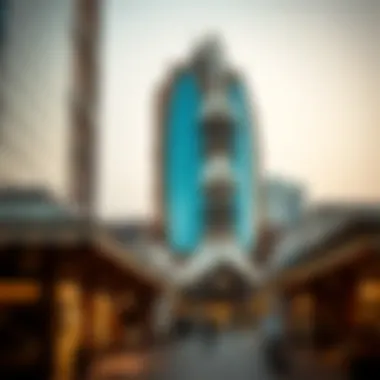

Real Estate Market Dynamics
The real estate market in Bur Dubai and Al Ghubaiba is a fascinating reflection of the areas' growth and cultural evolution. An understanding of the dynamics at play is crucial for investors, homeowners, and analysts who are keen on navigating these vibrant neighborhoods. With increasing urbanization in Dubai, the real estate landscape is not only expanding but also evolving to meet the diverse needs of its inhabitants and stakeholders.
Current Trends in Property Development
Property development in these areas has been influenced by both local and international interest. Recent years have seen a remarkable surge in high-rise apartments and mixed-use developments. Investors are focusing on eco-friendly projects as sustainability takes priority. Many developers are adopting modern architectural styles that blend with the area's rich cultural heritage.
The trend towards larger, open-plan living spaces is also noteworthy. Prospective buyers now favor properties that provide not only a home but also lifestyles that promote community engagement. This has encouraged a proliferation of amenities, such as parks and recreational facilities, which are seen as attractive selling points.
"Investing in these neighborhoods today could result in substantial returns, given the thriving demand for quality residential and commercial spaces."
Additionally, there’s an increasing inclination towards properties with smart technology integrations. Features like energy-efficient appliances and automated home systems are appealing to a tech-savvy demographic.
Investment Opportunities
Investors looking towards Bur Dubai and Al Ghubaiba should note the unique opportunities available. The growing demand for rental properties is significant. Given the area's strategic location and robust transport infrastructure, these neighborhoods are highly sought after by expatriates and locals alike.
Key areas of investment include:
- Residential Apartments: With prices remaining competitive compared to other regions in Dubai, there’s a solid chance for capital appreciation.
- Commercial Real Estate: As the local economy diversifies, businesses are springing up, driving demand for office spaces.
- Mixed-Use Developments: Properties that combine residential, commercial, and retail spaces are ideal for investors, offering a range of income streams.
The government also provides incentives for foreign investment, reducing some of the barriers that previously hindered participation in the local property market. This proactive approach has attracted a wide range of international investors.
Property Types Available
The property landscape in Bur Dubai and Al Ghubaiba is an eclectic mix, catering to varied tastes and needs. Potential buyers can find a wide range of property types, including:
- Luxury Apartments: High-end living spaces often equipped with world-class amenities.
- Affordable Housing: Options for first-time buyers or investors looking for budget-friendly choices.
- Commercial Spaces: Ideal for businesses looking to tap into the bustling local market.
- Villas and Townhouses: Providing more spacious living options for families.
Overall, understanding the real estate market dynamics in Bur Dubai and Al Ghubaiba allows for informed decisions and strategic investments. The combination of rapid growth, government support, and evolving consumer preferences creates an inviting atmosphere for all stakeholders in the property market.
Living in Bur Dubai and Al Ghubaiba
Living in Bur Dubai and Al Ghubaiba offers a unique blend of culture, modernity, and community living. Both regions are steeped in history and have transformed over the years into vibrant urban centers. The significance of discussing life in these areas is multifaceted. There’s much to consider, from demographics and community engagement to the essential services that shape daily living. Understanding these elements is crucial for potential investors, homeowners, and those looking to move to the area.
Demographics and Community
The demographics of Bur Dubai and Al Ghubaiba reflect a rich tapestry of cultures and backgrounds. Historically a hub for traders and merchants, Bur Dubai has gradually evolved into a melting pot where you can hear an array of languages being spoken—from Arabic to Hindi, and even Tagalog. This diversity contributes to a sense of community that feels open and welcoming.
Residents come from various walks of life, creating a neighborhood that balances tradition with modern demands. The sense of belonging is palpable, as many families have lived here for generations. Community hawkers, local markets, and vibrant street festivals add a distinct charm, making the area more than just a place to live; it’s a lifestyle.
Public Amenities and Services
Public amenities in Bur Dubai and Al Ghubaiba are designed to cater to the diverse needs of their populations. Here’s a quick overview:
- Parks and Recreation: There are a number of parks, such as the Bur Dubai Park, offering green spaces for families and individuals to unwind.
- Shopping Centers: Well-known shopping venues like The Dubai Mall and Burjuman Mall attract both locals and tourists alike, featuring a mix of international and local brands.
- Markets: Traditional souks, like the Textile Souk and Spice Souk, provide a sensory experience that is as much about shopping as it is about connecting with the local culture.
- Transport Links: A robust transportation network, including the Dubai Metro and various bus lines, ensures mobility across the city and keeps residents connected to the rest of Dubai.
The accessibility of services, from public transportation to health centers, shows a commitment to improving residents' quality of life.
Educational Institutions
Education plays a crucial role in any region, and both Bur Dubai and Al Ghubaiba feature several educational institutions catering to a wide range of curriculums. Schools offering British, American, and Indian education systems are prevalent. Notable institutions include:
- The Westminster School: Known for its rigorous academic standards, it caters primarily to expatriate communities.
- Indian High School: This school has a rich legacy and is one of the largest in Dubai, with a focus on Indian curriculum.
- Dubai Modern Education School: Offers a mix of local and international educational approaches, welcoming a diverse student body.
In addition, various tutoring centers and after-school programs are available to ensure comprehensive educational support for students of all ages.
Healthcare Facilities
Healthcare in Bur Dubai and Al Ghubaiba is robust, with a variety of facilities to choose from. Access to quality medical care is vital for both residents and potential newcomers. The healthcare landscape includes:
- Dubai Hospital: A leading state hospital that provides comprehensive healthcare services and is recognized for its advanced medical technology.
- Mediclinic City Hospital: A private facility known for its specialty care and high patient satisfaction rates.
- Community Clinics: Smaller clinics and pharmacies dotted throughout the districts offer accessible and affordable medical services.
Additionally, health and wellness initiatives, including fitness centers and wellness workshops, are increasingly popular, further enhancing the quality of life in these regions.
“Understanding and integrating into the community is essential for a fulfilling life in Bur Dubai and Al Ghubaiba.”
Living in Bur Dubai and Al Ghubaiba is more than just finding a place to sleep; it’s about choosing a lifestyle rich in culture, accessible services, and a sense of belonging. As urban centers, they continue to evolve and adapt, making them appealing choices for investors and residents alike. As we delve deeper into these regions, we uncover their potential and challenges, equipping you with the knowledge to make informed decisions.
Transportation and Accessibility
Transportation and accessibility play a pivotal role in the real estate dynamics of Bur Dubai and Al Ghubaiba. The ease with which residents and visitors can navigate through these areas directly influences property values and the quality of life. Whether commuting to work or exploring local attractions, efficient transport systems are essential for these vibrant communities.
Public Transport Options
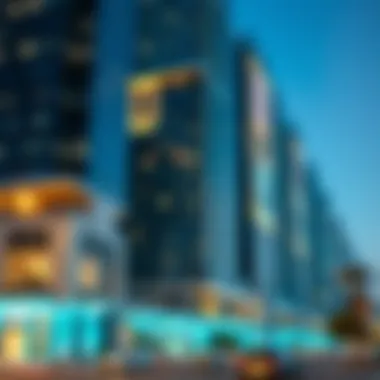

In Bur Dubai and Al Ghubaiba, the public transport system is quite robust, offering a comprehensive range of options for getting around. The Dubai Metro, particularly the Green Line, serves as a backbone, providing quick access to major parts of the city. It connects residents not only to commercial hubs but also to popular sites like the Dubai Museum and the vibrant textile souk.
Buses are another essential mode of public transport. They cover areas not serviced by the Metro, delivering commuters directly to their destinations. The vast network of bus routes means that residents can hop on a bus to get to work or visit friends without much hassle.
Moreover, taxis are readily available, making them a popular choice for those preferring door-to-door service. Ride-sharing apps, such as Uber and Careem, are also increasingly seen, providing additional convenience, especially during late hours when other public transport options may be limited.
Road Connectivity
Road connectivity in Bur Dubai and Al Ghubaiba is characterized by major arterial roads that weave through the heart of the city. Sheikh Khalifa Bin Zayed Road is a key thoroughfare, linking these neighborhoods with other parts of Dubai and facilitating easy commuter flow.
Additionally, the roads are well-maintained, which enhances driving experiences for those who own vehicles. Having good access to the main highways elevates the attractiveness of properties, making them appealing to both investors and renters.
Consider this:
A well-connected area in terms of roadways typically sees an increase in real estate interest, leading to higher uhousing demand and prices.
Furthermore, with recent road upgrades and expansions taking place, the already impressive connectivity will likely see continued improvement in the coming years.
Future Transit Plans
In terms of future developments, the local government has ambitious plans to enhance transit options further. An example includes proposals for extending the Dubai Metro lines, enhancing connectivity not just within Bur Dubai and Al Ghubaiba but across Dubai, creating a seamless commuting experience.
There are discussions about adding more bus routes aimed at reducing congestion while also hooking up underserved areas. These changes signal a commitment to sustainable urban mobility, which will likely lead to a more vibrant economic environment and increased attractiveness for property investments.
As these transportation schemes come to fruition, they will undoubtedly shape the residential and commercial landscape, influencing where people choose to live and work. Such developments not only improve day-to-day living but can also contribute to the area's overall economic growth.
Cultural Influence and Heritage
Cultural influence and heritage serve as the backbone of Bur Dubai and Al Ghubaiba's identity. These areas embody a rich tapestry woven by myriad cultural threads, each contributing to the vibrancy of the communities residing there. The importance of this cultural landscape cannot be overstated for investors, homeowners, and market analysts looking to grasp the soul of the neighborhoods in these locales. Potential returns in the real estate market largely hinge on understanding not just the physical properties, but also the cultural nuances that imbue them with character and uniqueness.
Key Aspects of Cultural Influence:
- Historical Significance: The echoes of yesteryears resonate strongly here. From the historic Al Fahidi District to the bustling souks, every corner tells a story.
- Diversity and Inclusivity: With a melting pot of cultures, Bur Dubai and Al Ghubaiba are places where traditions coexist. This diversity attracts a wide range of potential residents and tourists alike.
- Community Engagement: Local events and festivals not only enhance community cohesion but also foster economic activity, which is critical for future investment prospects.
Understanding these layers of cultural identity empowers stakeholders to make informed decisions. Whether it's a new development project or inviting tourists for festivals, knowing the heritage narrative adds value to actions taken in these communities.
Museums and Cultural Experiences
The museums and cultural experiences in Bur Dubai and Al Ghubaiba are essential for grasping the historical and contemporary significance of these areas. Points of interest like the Dubai Museum present curated exhibits reflecting the evolution of Dubai from a humble fishing village to a global metropolis. The ambiance within these museums invites exploration and sparks curiosity.
Cultural Experiences Include:
- Dubai Museum: Housed in the Al Fahidi Fort, it beautifully narrates the story of Dubai through various artifacts.
- Virtual Reality Experiences: Some modern offerings immerse visitors in a digital re-creation of historical events, bridging the past and the present succinctly.
- Guided Tours: Knowledgeable local guides fill in the gaps with anecdotes and lesser-known stories that add richness to the facts.
These sites do not only serve educational purposes but also act as attractions in their own right for potential real estate ventures, as they enhance the locality's appeal to a broader audience.
Art and Local Craftsmanship
Bur Dubai and Al Ghubaiba are treasure troves of art and craftsmanship, showcasing the creativity of local artisans while preserving age-old traditions. Art is alive here, from galleries displaying contemporary works to traditional craft shops where skilled hands mold clay, weave textiles, or carve intricate woodwork.
Noteworthy Aspects Include:
- Art Galleries: Places like the Art AlUla Gallery showcase both local and regional talent, becoming popular spots for art enthusiasts and collectors.
- Craft Markets: The Persian and textile souks not only offer unique shopping experiences but also create opportunities for artisans to exhibit their goods.
- Folk Art Events: Regularly held exhibitions and pop-up markets place local craftsmanship center stage, promoting a sense of pride within the communities involved.
By fostering and celebrating local art, Bur Dubai and Al Ghubaiba not only enhance their aesthetic value, but they also solidify their economic foothold by attracting visitors looking for unique cultural offerings.
Festivals and Community Events
Festivals and community events form a lively pulse within Bur Dubai and Al Ghubaiba. They reflect both the heritage and the cosmopolitan spirit of these regions. Events such as the Dubai Shopping Festival or the Ramadan Night Market become focal points bringing together diverse communities.
Key Community Events:
- Diwali Celebrations: Of particular note is how well the Diwali festivities are integrated, drawing in significant participation from local Indian communities, adding a festive atmosphere.
- Art Dubai: An international art fair which draws attention from global art collectors and enthusiasts, boosting tourism.
- Cultural Fests: Such events often include performances, handicraft displays, food markets, and workshops that showcase various cultural traditions.
These events provide additional layers of attractiveness for potential investors and homeowners. A rich calendar of events enhances the lifestyle offering in these neighborhoods, making them enticing places to live and invest in.
"Cultural heritage is not just what is left behind; it is a living part of the community's identity, enshrining values and aspirations for the future."
In summary, the cultural influence and heritage of Bur Dubai and Al Ghubaiba are pivotal to understanding these districts. By exploring the museums, local art, and community events, stakeholders can fully appreciate the charm and potential these neighborhoods hold.
The Economic Outlook
In exploring the economic landscape of Bur Dubai and Al Ghubaiba, one quickly realizes that these areas are not just historical landmarks but also bustling economic hubs. The economic outlook serves as a critical lens through which investors and residents can gauge the vitality of these neighborhoods, understanding how trends and shifts may influence livelihoods and property values.
The significance of this topic goes beyond mere numbers. It involves dissecting the major economic drivers at play, assessing the impact of tourism, and analyzing the evolving job market. Each element presents unique opportunities and vulnerabilities, especially in a region experiencing rapid growth.
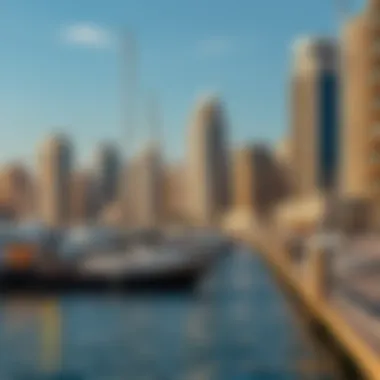

Major Economic Drivers
Bur Dubai and Al Ghubaiba exemplify a snapshot of Dubai's broader economic ambitions. These areas serve as key players in the emirate's diversified economy, driven by several factors:
- Trade and Commerce: Both neighborhoods are sprinkled with traditional souks and modern malls, making them commercial magnets.
- Real Estate Development: New buildings and renovations have converted many structures into modern yet culturally rich spaces, enhancing property values.
- Tourism: With significant historical appeal combined with modern attractions, the region draws tourists, thus boosting local businesses.
In essence, these economic drivers not only propel growth but also fortify Bur Dubai and Al Ghubaiba's positions in the competitive Dubai marketplace.
Tourism Impact
Tourism serves as a lifeblood for Bur Dubai and Al Ghubaiba, creating a tapestry where culture and commerce intertwine. The influx of visitors has led to:
- Economic Boost: Local businesses, from restaurants to retailers, thrive on the foot traffic brought in by visitors exploring the rich history and modernity of the area.
- Job Creation: More tourists mean more jobs, especially in hospitality and service sectors. This fluctuation benefits locals seeking employment opportunities.
- Investment Opportunities: The tourism-driven economy attracts investors looking to leverage this ever-expanding market, particularly in hotel and residential developments.
"The more tourists that flock to the shops and sights, the more the economy of Bur Dubai flourishes, creating an enticing environment for both business and leisure."
Evolving Job Market
The job market in Bur Dubai and Al Ghubaiba is notably dynamic, shaped by the changing demands of the economy. Factors influencing this evolution include:
- Sector Diversification: As the region grows, there's a need for skilled professionals in various sectors, from technology to healthcare.
- Education and Training: With numerous educational institutions in the vicinity, local residents are increasingly qualified to fill these new roles, enhancing community prospects.
- Young Workforce: The youthful population in Dubai brings innovative ideas and tech-savvy skills, appealing to companies seeking fresh perspectives.
The evolving job market not only supports economic stability but also positions both areas as attractive locales for professionals and entrepreneurs alike.
Potential Challenges
The exploration of Bur Dubai and Al Ghubaiba inevitably leads to a discussion about the potential challenges that could impact these vibrant areas. Understanding the intricacies of these difficulties is crucial for investors, homeowners, and market analysts alike. Examining aspects such as urbanization pressures, market volatility, and environmental considerations offers insights that could shape future investments and lifestyle choices.
Urbanization Pressures
Urbanization in Bur Dubai and Al Ghubaiba has been a double-edged sword. On one hand, the rapid development brings economic growth and infrastructural advancements. On the other hand, it poses significant pressures on local resources, housing, and quality of life.
As the population swells, demand for housing increases exponentially, leading to overcrowded neighborhoods. Gentrification is also at play, where local charm can be overshadowed by the rise of high-rise buildings and commercial hubs. Residents and potential homeowners must navigate this changing landscape carefully.
- Increased Housing Costs: As demand surges, rental prices and property values also skyrocket, making affordability a pressing concern.
- Strain on Infrastructure: Public services, such as waste management and water supply, can buckle under the sheer weight of urbanization. Local amenities may also struggle to keep pace with the burgeoning population.
- Cultural Erosion: With newcomers flocking in, there is a palpable risk of losing the cultural fabric that defines these historic districts. The challenge is to strike a balance between modernization and preserving heritage.
Market Volatility
The property market within Bur Dubai and Al Ghubaiba, while promising, comes with its own set of challenges marked by volatility. Such fluctuations can create uncertainty for both investors and residents, often shaping their purchasing decisions.
Market dynamics are influenced by broader economic indicators, government policies, and global events. For instance, changes in foreign investment laws could either inflate or deflate market enthusiasm, leading to erratic pricing.
It’s wise to be mindful of:
- Investment Risks: Investors must stay informed about market trends to mitigate risks. Unforeseen events can lead to sudden downturns.
- Timing the Market: Beginners may find it hard to predict the right moment to buy or rent, causing missed opportunities or financial losses.
- Regulatory Changes: Staying abreast of local regulations becomes more critical, as even minor changes can have significant implications for the market.
Environmental Considerations
Finally, environmental considerations cannot be overlooked in the dialogue about Bur Dubai and Al Ghubaiba's future. Rapid urbanization inevitably leads to ecological changes that can impact both residents and investors.
- Climate Concerns: With rising temperatures and changing weather patterns, Bur Dubai and Al Ghubaiba face challenges related to sustainability. Water scarcity and heat can significantly affect living conditions.
- Green Spaces: The push for urban development often sees green areas sacrificed. This can affect community well-being and air quality, making it crucial for city planners to integrate parks and recreational areas into development plans.
- Pollution Levels: As more vehicles hit the roads, air quality deteriorates. This is a significant quality-of-life consideration for any prospective resident.
In summation, understanding these potential challenges equips stakeholders with the knowledge required to navigate the complexities of living or investing in Bur Dubai and Al Ghubaiba. Combining informed choices with a respect for the unique culture and history of these areas will only enhance their appeal in the long run.
Looking Ahead: Future Developments
As Bur Dubai and Al Ghubaiba continue to evolve under the weight of rapid urbanization, the topic of future developments cannot be overstated. Understanding this landscape is crucial not only for investors seeking fruitful opportunities but also for residents and city planners who are grappling with the complexities of growth. This section will elaborate on the upcoming projects, the predicted market trends, and the long-term sustainability goals that are pivotal in shaping the future of these vibrant communities.
Upcoming Projects
In the heart of Bur Dubai and Al Ghubaiba, several ambitious projects are on the horizon. One notable initiative is the Dubai Creek Harbour, which is anticipated to redefine waterfront living with a blend of residential options and green spaces. Another project generating buzz is the Museum of the Future, aimed at positioning Dubai as a leader in innovation and cultural tourism.
Not only do these projects aim to enhance the skyline, but they also prioritize community involvement and interaction. Facilities like parks, recreational centers, and pedestrian-friendly environments are set to elevate the lifestyle of residents while catering to tourists.
These developments are essential as they promise to enhance the infrastructure and promote sustainable practices. Moreover, investors keeping an eye on these projects stand to benefit from increased property values and a surge in demand for commercial and residential spaces.
Predicted Market Trends
The real estate market in Bur Dubai and Al Ghubaiba is poised for notable transformations. Analysts predict an uptick in demand fueled by both local and foreign investments. As the cities continue to diversify their economic bases beyond just tourism, sectors such as technology and green industries are projected to emerge.
One particular trend that stands out is the shift towards eco-friendly housing. As environmental concerns gain traction, there’s an evident preference among buyers for properties that boast energy efficiency and sustainability features. In addition, the impending opening of new transport links is likely to boost property desirability in areas once considered remote. The anticipated increase in population density will also challenge and motivate developers to innovate in terms of affordable housing solutions.
"The future of property in Bur Dubai and Al Ghubaiba is not just about building but also about creating sustainable and inclusive communities."
Long-term Sustainability Goals
Sustainability is at the forefront of the planning processes in Bur Dubai and Al Ghubaiba. City planners are increasingly emphasizing the importance of creating environments that not only foster economic growth but also prioritize ecological health. To this end, several long-term sustainability goals have been drawn up.
- Green Initiatives: Both districts are set to incorporate more green areas and efficient waste management systems. This is aimed to combat urban heat build-up and to create a healthier living atmosphere.
- Sustainable Transportation: The push towards enhanced public transportation options, including electric buses and bike lanes, reflects a commitment to reduce carbon emissions and ease traffic congestion.
- Community Engagement: Engaging residents in sustainability initiatives is becoming a norm, with educational programs and community-driven environmental projects gaining traction.
As these plans unfold, the hope is to balance growth with environmental stewardship, ensuring Bur Dubai and Al Ghubaiba not only remain appealing but also sustainable for generations to come.




